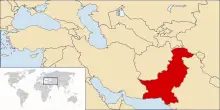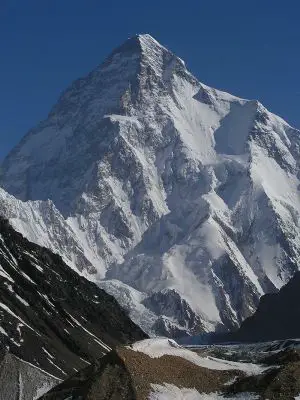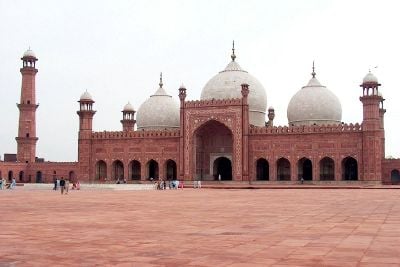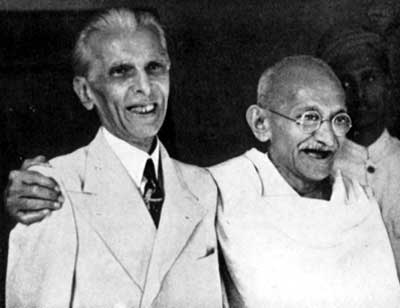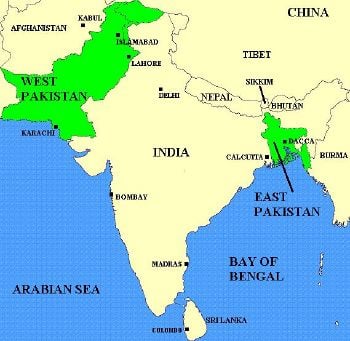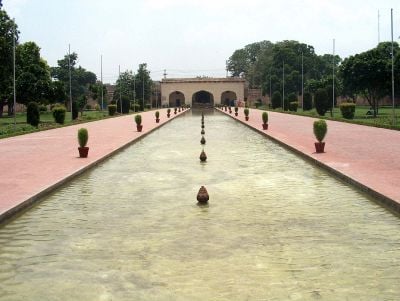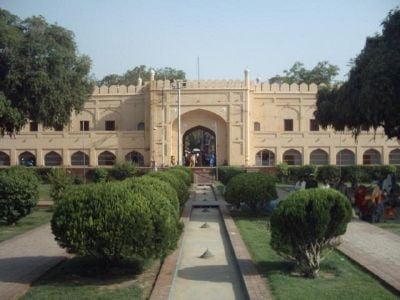Pakistan
| اسÙاÙ
Û Ø¬Ù
ÛÙرÛÛ Ù¾Ø§Ú©Ø³ØªØ§Ù IslÄmÄ« JumhÅ«rÄ«-ye PÄkistÄn Islamic Republic of Pakistan |
||||||
|---|---|---|---|---|---|---|
|
||||||
| Motto: Unity, Discipline, Faith (Urdu: اتØØ§Ø¯Ø ØªÙظÙÙ Ø ÙÙÙÙ Ù ÙØÚ©Ù ) Ittehad, Tanzeem, Yaqeen-e-Muhkam |
||||||
| Anthem: QaumÄ« TarÄna |
||||||
| Area controlled by Pakistan in dark green;
claimed but uncontrolled territory in light green
|
||||||
| Capital | Islamabad | |||||
| Largest city | Karachi | |||||
| Official languages | Urdu (national) English |
|||||
| Recognized regional languages | Balochi, Pashto, Punjabi, Saraiki, Sindhi, Hindko, Brahui [1] | |||||
| Demonym | Pakistani | |||||
| Government | Federal Parliamentary republic | |||||
| Â -Â | President | Arif Alvi | ||||
| Â -Â | Prime Minister | Shehbaz Sharif | ||||
| Â -Â | Chief Justice | Qazi Faez Isa | ||||
| Â -Â | Chair of Senate | Sadiq Sanjrani | ||||
| Â -Â | House Speaker | Ayaz Sadiq | ||||
| Legislature | Majlis-e-Shoora | |||||
| Â -Â | Upper House | Senate | ||||
| Â -Â | Lower House | National Assembly | ||||
| Formation | ||||||
| Â -Â | Pakistan Declaration | 28 January 1933Â | ||||
| Â -Â | Pakistan Resolution | 23 March 1940Â | ||||
|  - | Independence | from the United Kingdom | ||||
| Â -Â | Declared | 14 August 1947Â | ||||
| Â -Â | Islamic Republic | 23 March 1956Â | ||||
| Area | ||||||
|  - | Total | 796,095 km² (36th) 307,374 sq mi |
||||
|  - | Water (%) | 3.1 | ||||
| Population | ||||||
| Â -Â | 2023Â census | 241,499,431[2][3]Â (5th) | ||||
|  - | Density | 273.8/km² (56th) 633/sq mi |
||||
| GDPÂ (PPP) | 2023Â estimate | |||||
| Â -Â | Total | |||||
| Â -Â | Per capita | |||||
| GDP (nominal) | 2023Â estimate | |||||
| Â -Â | Total | |||||
| Â -Â | Per capita | |||||
| Gini (2018) | 29.6[5] | |||||
| Currency | Pakistani Rupee (Rs.) (PKR) |
|||||
| Time zone | PST (UTC+5) | |||||
|  - | Summer (DST) | PDT (UTC+6) | ||||
| Internet TLD | .pk | |||||
| Calling code | [[+92]] | |||||
The Islamic Republic of Pakistan, or Pakistan, is a country located in South Asia, marking the region where South Asia converges with Central Asia and the Middle East. Its eastern provinces are located in the northwestern corner of the Indian subcontinent, while the western provinces are contiguous with the Iranian plateau. It borders Iran to the west, Afghanistan on the northwest, China to the northeast, India on the east, and has a 650 mile (1046 km) coastline along the Arabian Sea to the south.
Pakistan is the sixth most populous country in the world. It also has the second largest Muslim population in the world. Its territory was a part of the pre-partitioned British India and has a long history of settlement and civilization, including the Indus Valley Civilization.
The name "Pakistan" in the Urdu and Persian languages means, "Land of the Pure." The name is believed to have been coined by Choudhary Rahmat Ali, who devised the word and first published it in 1933, in the pamphlet, Now or Never. He saw it as an acronym formed from the names of the "homelands" of Muslims in South Asia: With P standing for Punjab, A for the Afghan areas of the region, K and I for Kashmir, S for Sindh, and TAN for Baluchistan, thus forming Pakistan.
Geography
The northern and western areas of Pakistan are mountainous. Pakistani-administered areas of Kashmir contain some of the highest mountains in the world, including K2 and Nanga Parbat. Northern Pakistan has many areas of preserved, moist temperate forest.
In the southeast is the Cholistan, or Thar Desert, which extends into India. West-central Baluchistan has a high desert plateau, bordered by low mountain ranges. Most areas of Punjab, and parts of Sindh, are fertile plains where agriculture is of great importance.
Climate
Pakistan has many different types of climate and scenery. Along the flat, southern coast, there are sandy beaches, lagoons, and mangrove swamps. At the opposite end of the country are the icy peaks of the Himalaya, Karakoram, and Hindu Kush mountain ranges, many of them over 7,000 m and covered in snow and glaciers. Linking these two areas and running down the middle of Pakistan is the Indus River and its many tributaries. To the west of the Indus are the dry, hilly deserts of Baluchistan; to the east are the rolling sand dunes of the Thar Desert. Pakistanâs climate varies as much as its scenery, with very cold winters and hot summers in the north and a mild maritime-influenced climate in the south. The central part of the country has extremely hot summers, with temperatures rising to 45ºC, followed by cold winters, often in below-freezing temperatures in the north.
All of Pakistan receives very little rain, ranging from less than 250 mm to more than 1,250 mm, mostly brought by the southwesterly monsoon winds during the late summer. However, the monsoons are unreliable; in some years they bring a lot of rain and in other years very little. Much of the rain is lost through evaporation because it falls at the hottest time of the year. This results in a water shortage for crops, a problem Pakistan has solved by constructing many dams on the rivers to store water and release it when the farmers need it in the fields. In many drier areas, water wells have been sunk to ease the water shortage problem.
Wildlife
The wide variety of landscapes and climates in Pakistan allows for a wide variety of wild animals and birds. In the south, there are crocodiles in the murky waters at the mouth of the Indus River whilst on the banks of the river, there are boars, deer, porcupines, and small rodents.
In the sandy scrublands of central Pakistan, jackals, hyenas, wild cats, panthers, and leopards roam in search of food. In the north, some of the rarest animals in the world can be seen in the mountains and valleys. They include Marco Polo sheep and Urial sheep; Markhor and Ibex goats with long, curved horns; black and brown Himalayan bears; and the very rare snow leopard. The clear blue skies abound with hawks, falcons, and eagles.
In recent years, the government has become concerned with the number of wild animals being killed for fur and leather trading. Some species of animals were in danger of being wiped out altogether because hunters had killed so many of them. In 1981, Parliament passed a law banning the hunting of wild animals and birds, but many people ignore the law. Due to this negligence, the government has established several wildlife sanctuaries and game reserves where animals can live in safety from hunters. These special parks have towers and hideouts to enable people to observe the animals without disturbing or harming them.
Another rare species is the Indus River dolphin, a blind cetacean inhabiting the area where the rivers of Punjab meet the Indus. There are believed to be about 1,000 Indus dolphins remaining, and they are protected in two major sanctuaries.
History
As one of the cradles of human civilization, the Pakistani region has long been at the crossroads of history. It was the birthplace of some of the most ancient civilizations and a strategic center of historic trade routes, including the Silk Road. Pakistan was the site of much of the Indus Valley Civilization and was subsequently occupied by many groups, including Dravidians, Aryans, Persians, Greeks, Greco-Bactrians, Kushans, White Huns, and Scythians. This period saw the area advance in trade and culture to a level where the Gandhara region and the great city of Taxila (Takshashila) became a great center of learning and development.
Ancient history
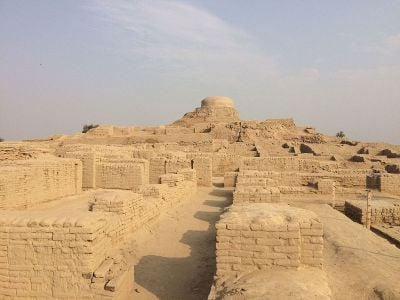
Unknown Neolithic populations lived in the region for millennia until sporadic settlements sprang up along the Indus Valley. These ancient settlements eventually culminated in the Indus Valley Civilization around 3000 B.C.E. The founders of this civilization are believed to be a Dravidian or Elamo-Dravidian people, but this remains difficult to verify, as there is no agreement on deciphering the the Indus Valley script. The Indus Valley Civilization spanned much of what is today Pakistan and western India, but declined shortly prior to the rise of the Vedic Civilization which, according to the contested Aryan invasion theory, resulted from the arrival in the North of the Subcontinent of tribes from Central Asia. The two cultures mixed to produce the Vedic Civilization that existed between the Sarasvati and Ganges rivers in what is now modern India around 1500 B.C.E. The Vedic Civilization helped shape subsequent cultures in South Asia. Some historians have challenged the Aryan Invasion Theory on the basis of new evidence, proposing instead that South Asian history shows a continuity of progress from the earliest times to today and that changes brought to the region by other cultures were not a major ingredient in the development of the Vedic Civilization.
Nearly all of ancient Pakistan was conquered by the Persian Achaemenid dynasty that ruled the area for over 200 years, beginning in 540 B.C.E. Alexander the Great defeated the king Porus (Paurava) in 326 B.C.E., at the Battle of the Hydaspes River, near Jhelum, and annexed the area to his Hellenistic empire. After Alexander's death and brief Seleucid control, Chandragupta Maurya gained control of the territory. His grandson, Ashoka, is known as one of the greatest proselytizers of Buddhism, which spread in the region. After the overthrow of the last ruler of the Mauryan Dynasty in 185 B.C.E., Demetrius I of Bactria conquered Gandhara and Punjab, establishing an Indo-Greek kingdom that lasted nearly two centuries, until around 10 B.C.E. To the south, this kingdom captured Sindh and extended to the coast of the Arabian Sea.
One of the most prominent Greco-Bactrian kings was Menander I, who ruled from 155 B.C.E. to 130 B.C.E. and is believed to have been a convert to Buddhism. His territories covered the eastern dominions of the divided Greek empire of Bactria (from the areas of Panjshir and Kapisa, now in Afghanistan) and extended to the Pakistani province of Punjab with diffuse tributaries to the south and east, possibly even as far as Mathura in modern India. Sagala (modern Sialkot) became his capital and prospered greatly under Menander's rule. The last Greek king to rule independently was probably Strato II, whose reign ended about 10 C.E. Various Greek kings ruled into the beginning of the first century C.E., as petty rulers (such as Theodamas) and as administrators, after the area was conquered by various Central Asian groups, most notably the Tocharian Kushans.
The Kushan kingdom stretched from modern-day Uzbekistan to Pakistan. The kingdom was founded by King Heraios and greatly expanded by his successor, Kujula Kadphises. Kadphises' son, Vima Takto, conquered territory now in India, but lost much of the western parts of the kingdom, including Gandhara, to the Parthian king Gondophares.
Later invaders included the Scythians and White Huns. While Punjab remained under the Huns and Scythians, the Sassanian Persian Empire came to control most of western Pakistan, Baluchistan, and the North-West Frontier Province, while parts of Sindh and Punjab came under the rule of Hindu rajas.
Arrival of Islam
In 712, the Umayyad dynasty sent an Arab-Muslim army, led by Muhammad bin Qasim, that conquered Sindh and Multan in southern Punjab. The arrival of the Arab-Muslims in the region set the stage for the geographic boundaries of the modern state of Pakistan and formed the foundation for Islamic rule that eventually spread across much of South Asia. Following the rule of various Islamic empires, including the Ghaznavid Empire, the Ghorid kingdom, and the Delhi Sultanate, the region was controlled by the Moghuls from 1526 until 1739. The Muslim technocrats, bureaucrats, soldiers, traders, scientists, architects, teachers, theologians, and Sufis flocked from the rest of the Muslim world to this Islamic sultanate. The Muslim Sufi missionaries played a pivotal role in converting the millions of native people to Islam. From 1739 until the early nineteenth century, the region of Pakistan was ruled briefly by Nadir Shah and then by the Afghans. Later the Baluchis and Sikhs came to control Sindh and Punjab.
British rule
The British originally arrived in South Asia to trade in tea, tobacco, and poppy, and formed the British East India Company, which would eventually spearhead a colonial domination over South Asia. The shrinking Mughal Empire fell prey to the East India Company's conspiracies, and the eventual collapse of the freedom struggle against the British by the Muslim leader Tipu Sultan (1749-99) left the remnants of the Mughal Empire completely vulnerable. The British did not gain strong footholds in present day Pakistan until the early nineteenth century and annexed the entire area during the Great Game rivalry with the Russian empire.
While the Anglo-Afghan wars for freedom continued well into the twentieth century, the Indian War of Independence, dubbed the "Sepoy Mutiny" by the British, in 1857 was the region's last major armed struggle against the British. The last Mughal Emperor, Bahadur Shah Zafar, was used as a figurehead by the rebellion, so the British decided to oust the emperor and exiled him to Rangoon, Burma (now Yangon, Myanmar).
Even though the War of Independence was a joint Muslim-Hindu struggle to oust the British, the brunt of British retaliation was directed at the Muslim population of the empire, employing the infamous "divide and rule" policy. This suppression and subjugation helped set the stage for the creation of Pakistanâa state for the Muslims of South Asia. Muhammad Ali Jinnah, a British-educated South Asian Muslim leader who had once been hailed as the "best ambassador of Hindu-Muslim unity," adopted the cause and later earned the Urdu title of Quaid-e-Azam (Great Leader) and founder of Pakistan.
Post-independence
After a 60-year formal and generally unarmed struggle for independence, Pakistan came into existence in 1947, from the British Empire. The British divided up their empire into three parts: The central part, with a Hindu majority, became modern-day India; the western part along with parts of Punjab became West Pakistan, while East Bengal (the Muslim majority part of Bengal) became East Pakistan. The Partition of India resulted in the worst-ever recorded communal riots in the region and perhaps one of the worst in modern history. An estimated one to five million Muslims, Sikhs, Hindus, and others lost their lives as a direct consequence, and millions more became refugee migrants to the newly formed Islamic Republic of Pakistan.
In 1971, economic and political discontent in East Pakistanâgeographically separated from West Pakistanâand violent political repression escalated into a civil war in East Pakistan and the Indo-Pakistani War of 1971. The latter resulted in the secession of East Pakistan, which formed the independent state of Bangladesh (now an independent and sovereign nation with the world's third-largest Muslim population). Relations thawed in 1973, when Pakistan formally accepted diplomatic relations with Bangladesh. Today Bangladesh is one of Pakistanâs leading trading partners in cotton, fresh produce, machinery, and military equipment.
Present day Pakistan does not include some of the regions originally allocated to it. The Muslim-majority princely states of Junagadh and Manavadar, Kapurthala, and the district of Gurdaspur were quickly occupied by Indian troops, while the Muslim-majority state of Jammu and Kashmir was eventually occupied by Pakistan on the west and India on the east.
Both Junagadh and Hyderabad were formally annexed and integrated into India in 1948. Jammu and Kashmir is still an unresolved dispute as the two countries have fought three wars (1948, 1965, 1999) over the region.
Government and politics
Political history
Pakistan has been ruled by both democratic and military governments. The first decade was marred with political unrest and instability resulting in frequent collapses of civilian democratic governments. From 1947 to 1958, as many as seven Pakistani prime ministers either resigned or were ousted. This political instability paved the way for Pakistanâs first military takeover. In 1958, Pakistanâs civilian and first president, Iskander Mirza, in collaboration with General Mohammad Ayub Khan, abrogated the nation's constitution and declared martial law.
General Ayub Khan was the president from 1958 to 1969, followed by General Yahya Khan from 1969 to 1971. Civilian rule continued from 1972 to 1977, under Zulfikar Ali Bhutto, but he was deposed by General Zia-ul-Haq. General Zia conducted a referendum in the country in 1985, and subsequently became the president of Pakistan. He also conducted open elections, and Muhammad Khan Junejo was elected as prime minister in 1985. General Zia was killed in a plane crash in 1988, after which Benazir Bhutto, daughter of Zulfikar Ali Bhutto, was elected prime minister. She was the youngest woman in the world ever to be elected the head of government and the first woman to be elected to head a Muslim country. Her government was followed by that of Nawaz Sharif, and the two leaders alternated until the military coup by General Pervez Musharraf in 1999.
Nationwide parliamentary elections were again held in 2002. One notable outcome was the election of 91 women to Parliamentâthe largest number and percentage of women in the parliament of any Muslim-majority country.
Political parties
Before and during the creation of Pakistan in 1947, the largely secular and centrist All India Muslim League supported the creation of Pakistan while the far-right religious parties opposed the creation of Pakistan and supported a united South Asia.
The liberal, leftist Pakistan Peoples Party (PPP) emerged as a major political player during the 1970s. During the 1980s, a new political, anti-feudal movement was started by unorthodox and educated urban dwellers of Sindh, most prominently Karachi.
Foreign relations
Pakistan was an ally of the United States for much of its early history through the early 1960s. At the time, its relationship with the U.S. was so close and friendly that it was called America's "most-allied ally" in Asia. This changed, though, after the 1965 war with India, when, during the height of the Cold War, the U.S. placed heavy military sanctions on Pakistan, forcing it to agree to a cease-fire, which ended a war that was headed for a stalemate. Pakistanis felt betrayed and ill-compensated for the risks incurred in supporting the U.S.âafter the U-2 crisis of 1960, Soviet leader Nikita Khrushchev had threatened the nuclear annihilation of Pakistani cities.
In 1964, Pakistan signed the Regional Cooperation for Development (RCD) Pact with Turkey and Iran, when all three countries were closely allied with the U.S., and as neighbors of the Soviet Union, wary of perceived Soviet expansionism. To this day, Pakistan has a close relationship with Turkey. RCD became defunct after the Iranian Revolution, and a Pakistani-Turkish initiative led to the founding of the Economic Cooperation Organization (ECO) in 1985.
After the 1965 war, Pakistan distanced itself from the U.S., and its relations with China became stronger. Soon both nations declared their close friendship, causing concern among the Western powers. Pakistan actively supported the resolution to move official recognition for the Chinese U.N. seat from the Taiwan-based Republic of China to the Beijing government.
The U.S. maintained a lukewarm relationship until the Nixon administration. In 1971, Pakistan was involved in a civil war that led eventually to the loss of East Pakistan, now Bangladesh. Many Pakistanis believed that the 1971 Indo-Soviet Treaty of Friendship and Cooperation encouraged Indian belligerency during this crisis. China supported Pakistan and did not accept the new nation of Bangladesh for over three years, even though in 1973, Pakistan itself did. The U.S. also did not recognize Bangladesh in favor of Pakistan until after the Shimla Accord. Pakistan used its friendship with both China and the U.S. to bring the two countries together, arranging the secret visit of U.S. Secretary of State Henry Kissinger to Beijing.
The Soviet involvement in the war and the Chinese influence on Pakistan prompted the U.S. to bolster ties with its distanced ally, but the alliance would not approach its former strength until the Afghan war. In the 1980s, Pakistan was supplied by the U.S. with necessary arms and given help to train and support anti-Soviet freedom fighters in Afghanistan. The U.S. promised to provide Pakistan with F-16 fighter jets, although (because of the Pressler Amendment) only a few were eventually supplied. However, China chose to remain out of this alliance, providing moral support instead.
After the Afghan war, which ended in favor of the anti-Soviet alliance, the relationship with the U.S. deteriorated when sanctions were imposed on Pakistan along with India for their nuclear programs. All military aid was again barred. China came to Pakistan's aid, helping it further develop its military and air force and infrastructures. (Notably, Pakistan and China jointly funded the development of the JF-17 fighter jet.)
After the September 11, 2001, attacks in the U.S., and in support of the subsequent American-led assault on Afghanistan, current Pakistani president Pervez Musharraf aligned his government again with the U.S. and attempted to seal borders with Afghanistan and silence Islamic radicals along the border. Since this strategic re-alignment towards U.S. policy, economic and military assistance has been flowing from the U.S. to Pakistan. In recognition of its support in the "war on terrorism," in 2004, U.S. President George W. Bush designated Pakistan as a major non-NATO ally, making it eligible, among other things, to purchase advanced American military technology.
Besides the above-mentioned countries, Pakistan enjoys alliances with many Middle Eastern countries, such as Saudi Arabia and the United Arab Emirates. Pakistan Air Force pilots fly fighters for these two countries. Among former Soviet allies, Libya and Syria are the only two Middle Eastern countries with whom Pakistan enjoys excellent relations.
Pakistan is also an important member of the Organization of the Islamic Conference (OIC). Pakistan has used the OIC as a forum for Enlightened Moderation, its plan to promote a renaissance and enlightenment in the Islamic world. Besides the OIC, Pakistan is a member of the South Asian union of SAARC. The ECO is another major regional cooperation organization seeking to promote socio-economic development of its member states on the basis of their common needs and in keeping with the challenges taking place on the global economic scene. The organization was founded by Pakistan, Iran, and Turkey as the successor organization of the RCD.
Pakistan is the second-largest Muslim country in terms of population (after Indonesia) and its status as a declared nuclear power and the only Islamic nation to have that status also plays a part in its international role.
Economy
Pakistan, a developing country, has faced a number of challenges on the political and economic fronts. Although a very poor country when it became independent in 1947, in the 1960s, Harvard economists proclaimed it to be a model of economic development. In each of its first four decades, Pakistan's economic growth rate was better than the global average, but imprudent policies led to a slowdown in the late 1990s.
Since then, the Pakistani government has instituted wide-ranging reforms, and economic growth has accelerated in the current century. Pakistan's economic outlook has brightened and its manufacturing and financial services sectors have experienced rapid expansion. The growth of the non-agricultural sectors has changed the structure of the economy, and agriculture now only accounts for a much smaller proportion of the GDP. There has been a great improvement in its foreign exchange position and a rapid growth in hard currency reserves in recent years.
Shopping is a popular pastime for many Pakistanis, especially among the well-to-do and the 30-million-strong middle class. Karachi is especially known for the great contrast in shopping experiences, from burgeoning bazaars to modern multi-story shopping malls.
Tourism
The diversity of the nation's culture, people, and landscape helps make tourism a growth industry in Pakistan. The country also contains several ancient ruins. Pakistanis pride themselves on their tradition of hospitality (mehman-nawazi) to guests.
In the north, some of the highest mountains in the world attract mountaineers and adventurers from around the world. There are many scenic places with old army fortresses, towers, and other architecture. The Kalasha valley in Chitral is famous for its small community that follows pre-Islamic animist religions. The Kalasha claim descent from the army of Alexander the Great.
In the east, the Punjab offers a view into the many different civilizations that settled there. Lahore is Pakistan's cultural capital and a historic city. There are many examples of Islamic Mughal architecture, such as the Badshahi Masjid and the Shalimar Gardens in Lahore. Pakistan's film industry, nicknamed Lollywood, is also based there.
Demographics
Religion
Census data indicates that 96 percent of the population is Muslim, with an estimated 76 percent of the total being Sunnis and 20 percent Shi'as. Pakistan has the second-largest Sunni population in the world (after Indonesia) and the second-largest Shi'a population in the world (after Iran). Smaller Muslim sects include the Ismailis and the Dawoodi Bohras.
The non-Muslim population mainly comprises of Christians and Hindus, with smaller numbers of Ahmadis, Buddhists, Jews, Sikhs, Zoroastrians, and animists (mainly the Kalash in Chitral). Pakistan's religious demographics were significantly influenced by the movement of populations in 1947 (millions of Muslims moved to Pakistan, and millions of Hindus and Sikhs moved to India), and the wars in Afghanistan (millions of refugees who have become permanent residents).
Although today there are few Sikhs in Pakistan, the country has a significant place in Sikhism. Guru Nanak, the founder of Sikhism, was born in present day Pakistan, and it is said he received his message near Lahore. Therefore, the religion actually originated in Pakistan. Most of Sikhism's holy sites are located in Pakistan. Many other great Sikh leaders, including Ranjit Singh and several gurus, were born in Pakistan. Ranjit Singh is buried in Lahore.
Pakistan is also the birthplace of Mahayana Buddhism, the form of the religion practiced today by most Buddhists, including those in India, Japan, China, South Korea, and Vietnam. The religion enjoyed prominence in the northwestern section of the country up until the Islamic conquest.
Languages
Urdu and English are both recognized as the official languages of Pakistan. English is used by the government, corporate businesses, and the educated urban elite. Most universities use it as the medium of instruction for degree courses. Urdu is the lingua franca of the people, being widely spoken as a second language, although it is the mother tongue of only 8 percent of the population, mainly Muhajirs (Muslim refugees from India after 1947), while an unknown percentage of urban Punjabis appear to be switching to the usage of Urdu as well.
Additionally, nearly all Pakistanis speak mutually-intelligible regional Indo-Iranian languages of the Indo-European family. The most widely spoken is Punjabi, followed by Pashto, Sindhi, and Baluchi. In addition, small groups of non-Indo-European languages are also spoken, including Brahui (a Dravidian language), and Burushaski, a language isolate.
Ethnic groups
The population comprises several main ethnic groupsâPunjabis who are the largest group, Pashtuns, Sindhis, Seraikis, Muhajirs, Baluchis, and others . Smaller ethnic groups, such as Turwalis, Kafiristanis, and Kashmiris, are mainly found in the northern parts of the country.
Pakistan's census does not include the sizable refugee population from neighboring Afghanistan, which is found mainly in the NWFP and Baluchistan. From the 1980s, Pakistan accommodated over three million Afghan refugeesâthe largest refugee population in the world, including Pashtuns, Tajiks, and Hazaras. If Afghan refugees were added to the official population, total figures would alter the percentages of Pashtuns and the category of others.
A large number of Bengali immigrants are concentrated in Karachi, while hundreds of thousands of immigrants from Iran are scattered throughout the country. Pakistan is home to a small community of Sephardic Jews, but their numbers have been falling since the creation of Israel. There are also sizable communities of Persians, Chinese, Myanmari (Burmese), and East Africans. There are additional minorities of Arab and Greek descent.
Society and culture
Pakistan has in the past been invaded and occupied by many different peoples, including Huns, Persians, Arabs, Turks, Mongols, and various Eurasian groups, all of which left differences in culture among the various ethnic groups in matters such as dress, food, and religion.
Prior to the Islamic invasion, many Punjabis and Sindhis were Hindu and Buddhist. This later changed during the expansion of Islam through Pakistan by the Ummayad General Muhammad bin Qasim and later by Mahmud of Ghazni and others. Many cultural practices, foods, monuments, and shrines have been inherited from the rule of Muslim Mughal and Afghan emperors in all of southern Asia. Shalwar kameez, the Pakistani national dress, is one of the clothing styles inherited from these rich cultural roots. Women wear brightly colored shalwar kameez with embroidery for special occasions such as weddings while men often wear solid-colored shalwar kameez, usually with a sherwani, a coat that goes over the shalwar kameez.
Pakistani society is largely multilingual and multicultural. Religious practices of various faiths are an integral part of everyday life in society. Education is highly regarded by members of every socio-economic stratum. Traditional family values are highly respected and considered sacred, although urban families have grown into a nuclear-family system, owing to the socio-economic constraints imposed by the traditional joint-family system. The past few decades have seen the emergence of a middle class in cities such as Karachi, Lahore, Rawalpindi, and Hyderabad. The northwestern part of Pakistan, bordering Afghanistan, is highly conservative and dominated by centuries-old regional tribal customs.
Roots
The modern nation of Pakistan has inherited a very rich cultural and traditional background going back to the Indus Valley Civilization (2800-1800 B.C.E.). Traditional Sufi practices of Islam are very strong in Pakistani culture.
Holidays
Every year, thousands of Pakistanis travel to Mecca to join other Muslims from across the world in performing the Hajj pilgrimage. Many of the pilgrims are assisted by the government, which provides free plane and ship tickets to Saudi Arabia. Closely associated with the Hajj is the festival of Eid ul-Adha, for which Muslims sacrifice an animal in remembrance of the actions of the Prophet Ibrahim (Abraham). The meat is shared with friends, family, and the less fortunate. People wear their best clothes and go to the mosque for special prayers. Both Eid ul-Fitr and Eid ul-Adha are public holidays, when schools, shops, and offices are closed. A third Eid is the Eid-e-Milad-un-Nabi, in the third month (Rabi' al-awwal) of the Islamic Calendar, which celebrates the birthday of the Prophet Muhammad.
The Hindus, Buddhists, Sikhs, and Christians of Pakistan also celebrate their own festivals and saints' days. Sikhs come from across the world to visit the shrine of Guru Nanak at Hassan Abdal of Punjab. There are also several regional and local festivals, such as the Punjabi festival of Basant, which marks the start of spring and is celebrated by people flying kites.
Media
Pakistani music is rich and represented by a wide variety of forms. It ranges from traditional styles such as Qawwali and Ghazal Gayaki to more-modern forms that try to fuse traditional Pakistani music with Western music. The Qawwali maestro, Nusrat Fateh Ali Khan, is internationally renowned for creating a form of music synchronising Qawwali with Western music. Pakistan has produced many renowned Ghazal singers such as Mehdi Hassan, Farida Khanum, Abida Parveen, and Iqbal Bano. Popular forms of music also prevail, the most notable being film music. In addition are the diverse traditions of folk music in all provinces. The arrival of Afghan refugees in the western provinces has also rekindled Pashtu and Persian music in Pakistan. Peshawar has become a hub for Afghan musicians and a distribution center for Afghan music abroad. Afghan singers have become famous throughout the North-West Frontier Province and some have even married within the local population, strengthening the ethnic kinship of the Pashtuns on both sides of the Durand line.
A small indigenous movie industry, commonly known as "Lollywood," is based in Lahore. Movies made in "Bollywood," India's Mumbai-based movie industry, are banned in Pakistan. However, pirated discs are easily available, making Indian film stars very popular in Pakistan as well.
Globalization
Increasing globalization has expanded the influence of "Western culture" in Pakistan. Many Western restaurant chains, such as McDonald's and Kentucky Fried Chicken, have established themselves in Pakistan and are found in the major cities.
A large Pakistani diaspora exists in the West. Whereas Pakistanis in the U.S., Canada, and Australia tend to be professionals, the majority of emigrants to the U.K., Germany, and the Scandinavian nations come from a rural background and belong to the working class. Pakistan has more expatriates than any other Muslim country, with a large number of them living in the Middle East. Pakistani emigrants and their children influence their homeland culturally and economically, keeping close ties to their roots by traveling and returning to Pakistan and by investing there.
Notes
- â Central Intelligence Agency, Pakistan The World Factbook. Retrieved March 7, 2024.
- â This figure does not include data for Pakistan-administered areas of Kashmir; Azad Kashmir and Gilgit-Baltistan.
- â Population and Housing Census-2023 Pakistan Bureau of Statistics. Retrieved March 7, 2024.
- â 4.0 4.1 4.2 4.3 World Economic Outlook Database, October 2023 Edition. (Pakistan) International Monetary Fund. Retrieved March 7, 2024.
- â Gini Index World Bank. Retrieved March 7, 2024.
ReferencesISBN links support NWE through referral fees
- Banuazizi, Ali, and Myron Weiner. The State, Religion, and Ethnic Politics Afghanistan, Iran, and Pakistan. Contemporary Issues in the Middle East. Syracuse, NY: Syracuse University Press, 1986. ISBN 0815623852
- Halliday, Tony, Omar Noman, and Tahir Ikram. Pakistan. Insight Guides. Singapore: APA, 1998. ISBN 0887297366
- Halliday, Fred, and Hamza Alavi. State and Ideology in the Middle East and Pakistan. New York: Monthly Review Press, 1988. ISBN 0853457344
- Hammond World Atlas Corporation. Greater Middle East region including Afghanistan, Pakistan, Libya, and Turkey. Union, NJ: The Corp, 2001. ISBN 0843718277
- Malik, Hafeez (ed.). Pakistan Founder's Aspirations and Today's Realities. Karachi: Oxford University Press, 2001. ISBN 0195793331
- Wolpert, Stanley A. Jinnah of Pakistan. New York: Oxford University Press, 1984. ISBN 0195034120.
External links
All links retrieved March 7, 2024.
- Story of Pakistan
- Pakistan The World Factbook
- Pakistan US Department of State
- Pakistan Human Rights Watch
Credits
New World Encyclopedia writers and editors rewrote and completed the Wikipedia article in accordance with New World Encyclopedia standards. This article abides by terms of the Creative Commons CC-by-sa 3.0 License (CC-by-sa), which may be used and disseminated with proper attribution. Credit is due under the terms of this license that can reference both the New World Encyclopedia contributors and the selfless volunteer contributors of the Wikimedia Foundation. To cite this article click here for a list of acceptable citing formats.The history of earlier contributions by wikipedians is accessible to researchers here:
The history of this article since it was imported to New World Encyclopedia:
Note: Some restrictions may apply to use of individual images which are separately licensed.


